warning light LINCOLN MKT 2018 Owners Manual
[x] Cancel search | Manufacturer: LINCOLN, Model Year: 2018, Model line: MKT, Model: LINCOLN MKT 2018Pages: 564, PDF Size: 4.66 MB
Page 5 of 564
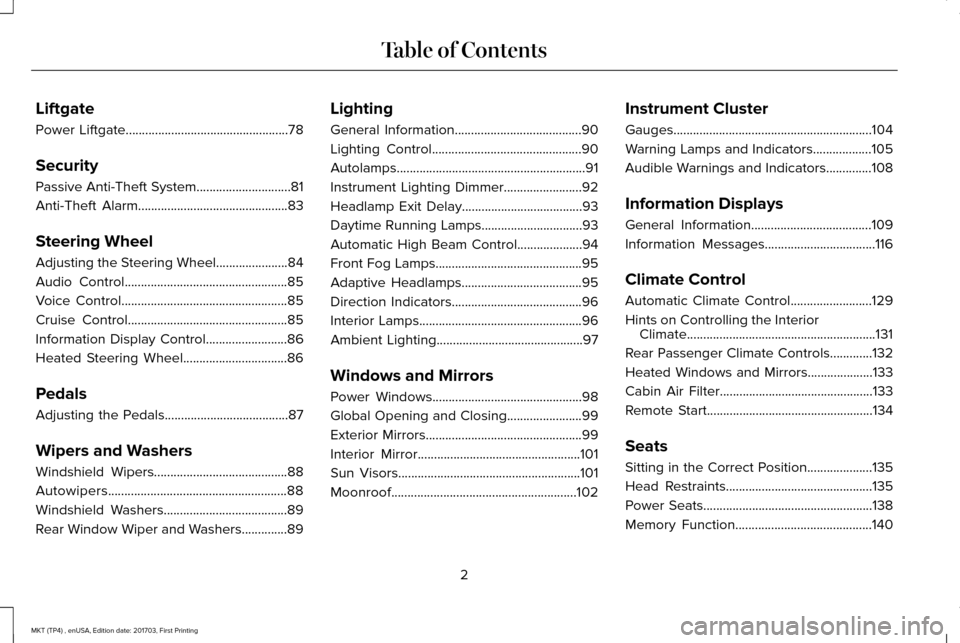
Liftgate
Power Liftgate..................................................78
Security
Passive Anti-Theft System.............................81
Anti-Theft Alarm..............................................83
Steering Wheel
Adjusting the Steering Wheel......................84
Audio Control
..................................................85
Voice Control
...................................................85
Cruise Control
.................................................85
Information Display Control
.........................86
Heated Steering Wheel................................86
Pedals
Adjusting the Pedals......................................87
Wipers and Washers
Windshield Wipers.........................................88
Autowipers.......................................................88
Windshield Washers
......................................89
Rear Window Wiper and Washers..............89 Lighting
General Information
.......................................90
Lighting Control..............................................90
Autolamps ..........................................................
91
Instrument Lighting Dimmer........................92
Headlamp Exit Delay.....................................93
Daytime Running Lamps...............................93
Automatic High Beam Control
....................94
Front Fog Lamps.............................................95
Adaptive Headlamps
.....................................95
Direction Indicators
........................................96
Interior Lamps
..................................................96
Ambient Lighting
.............................................97
Windows and Mirrors
Power Windows
..............................................98
Global Opening and Closing.......................99
Exterior Mirrors
................................................99
Interior Mirror
..................................................101
Sun Visors
........................................................101
Moonroof.........................................................102 Instrument Cluster
Gauges.............................................................104
Warning Lamps and Indicators..................105
Audible Warnings and Indicators
..............108
Information Displays
General Information
.....................................109
Information Messages
..................................116
Climate Control
Automatic Climate Control
.........................129
Hints on Controlling the Interior Climate
..........................................................131
Rear Passenger Climate Controls
.............132
Heated Windows and Mirrors
....................133
Cabin Air Filter
...............................................133
Remote Start
...................................................134
Seats
Sitting in the Correct Position....................135
Head Restraints
.............................................135
Power Seats....................................................138
Memory Function
..........................................140
2
MKT (TP4) , enUSA, Edition date: 201703, First Printing Table of Contents
Page 12 of 564
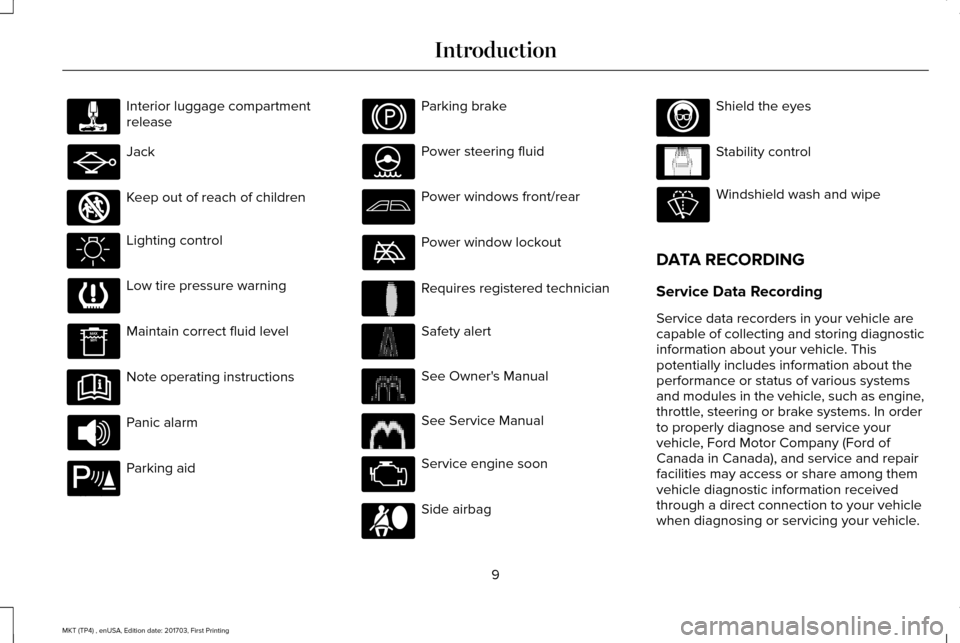
Interior luggage compartment
release
Jack
Keep out of reach of children
Lighting control
Low tire pressure warning
Maintain correct fluid level
Note operating instructions
Panic alarm
Parking aid Parking brake
Power steering fluid
Power windows front/rear
Power window lockout
Requires registered technician
Safety alert
See Owner's Manual
See Service Manual
Service engine soon
Side airbag Shield the eyes
Stability control
Windshield wash and wipe
DATA RECORDING
Service Data Recording
Service data recorders in your vehicle are
capable of collecting and storing diagnostic
information about your vehicle. This
potentially includes information about the
performance or status of various systems
and modules in the vehicle, such as engine,
throttle, steering or brake systems. In order
to properly diagnose and service your
vehicle, Ford Motor Company (Ford of
Canada in Canada), and service and repair
facilities may access or share among them
vehicle diagnostic information received
through a direct connection to your vehicle
when diagnosing or servicing your vehicle.
9
MKT (TP4) , enUSA, Edition date: 201703, First Printing Introduction E161353 E139213 E231159 E231158 E167012 E138639
Page 16 of 564
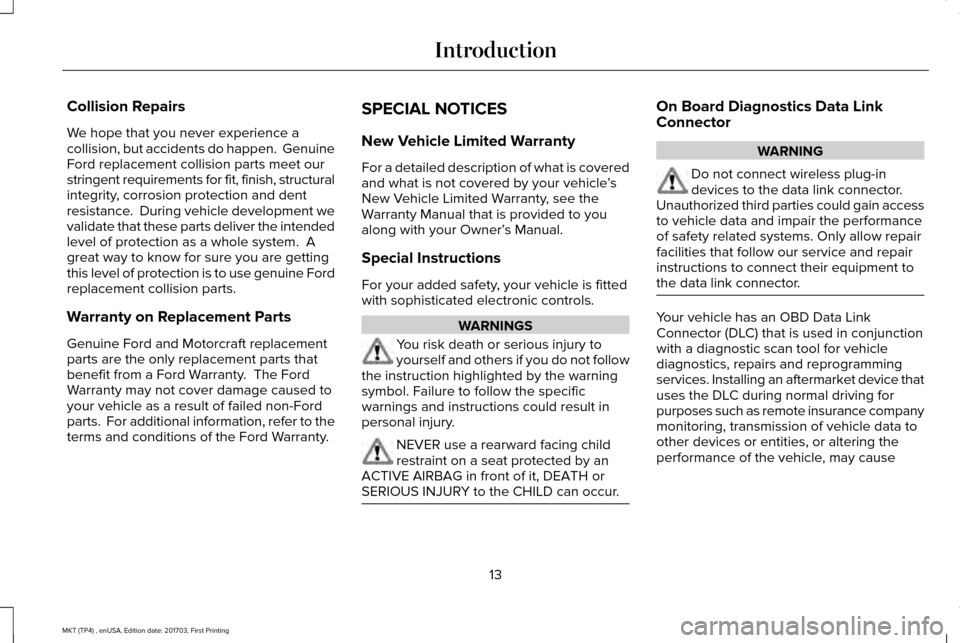
Collision Repairs
We hope that you never experience a
collision, but accidents do happen. Genuine
Ford replacement collision parts meet our
stringent requirements for fit, finish, structural
integrity, corrosion protection and dent
resistance. During vehicle development we
validate that these parts deliver the intended
level of protection as a whole system. A
great way to know for sure you are getting
this level of protection is to use genuine Ford
replacement collision parts.
Warranty on Replacement Parts
Genuine Ford and Motorcraft replacement
parts are the only replacement parts that
benefit from a Ford Warranty. The Ford
Warranty may not cover damage caused to
your vehicle as a result of failed non-Ford
parts. For additional information, refer to the
terms and conditions of the Ford Warranty.
SPECIAL NOTICES
New Vehicle Limited Warranty
For a detailed description of what is covered
and what is not covered by your vehicle
’s
New Vehicle Limited Warranty, see the
Warranty Manual that is provided to you
along with your Owner’ s Manual.
Special Instructions
For your added safety, your vehicle is fitted
with sophisticated electronic controls. WARNINGS
You risk death or serious injury to
yourself and others if you do not follow
the instruction highlighted by the warning
symbol. Failure to follow the specific
warnings and instructions could result in
personal injury. NEVER use a rearward facing child
restraint on a seat protected by an
ACTIVE AIRBAG in front of it, DEATH or
SERIOUS INJURY to the CHILD can occur. On Board Diagnostics Data Link
Connector
WARNING
Do not connect wireless plug-in
devices to the data link connector.
Unauthorized third parties could gain access
to vehicle data and impair the performance
of safety related systems. Only allow repair
facilities that follow our service and repair
instructions to connect their equipment to
the data link connector. Your vehicle has an OBD Data Link
Connector (DLC) that is used in conjunction
with a diagnostic scan tool for vehicle
diagnostics, repairs and reprogramming
services. Installing an aftermarket device that
uses the DLC during normal driving for
purposes such as remote insurance company
monitoring, transmission of vehicle data to
other devices or entities, or altering the
performance of the vehicle, may cause
13
MKT (TP4) , enUSA, Edition date: 201703, First Printing Introduction
Page 29 of 564
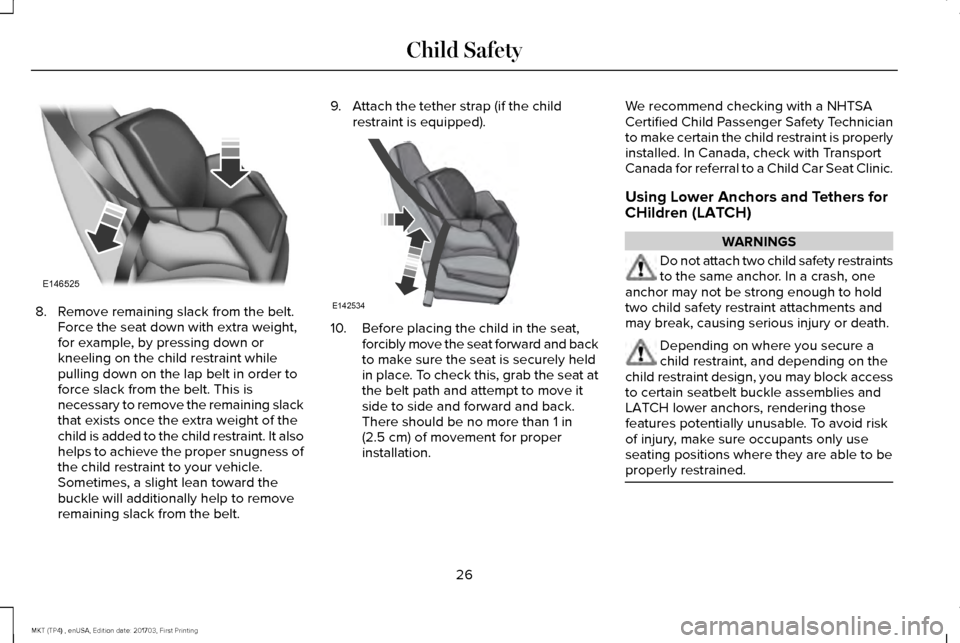
8. Remove remaining slack from the belt.
Force the seat down with extra weight,
for example, by pressing down or
kneeling on the child restraint while
pulling down on the lap belt in order to
force slack from the belt. This is
necessary to remove the remaining slack
that exists once the extra weight of the
child is added to the child restraint. It also
helps to achieve the proper snugness of
the child restraint to your vehicle.
Sometimes, a slight lean toward the
buckle will additionally help to remove
remaining slack from the belt. 9. Attach the tether strap (if the child
restraint is equipped). 10. Before placing the child in the seat,
forcibly move the seat forward and back
to make sure the seat is securely held
in place. To check this, grab the seat at
the belt path and attempt to move it
side to side and forward and back.
There should be no more than 1 in
(2.5 cm) of movement for proper
installation. We recommend checking with a NHTSA
Certified Child Passenger Safety Technician
to make certain the child restraint is properly
installed. In Canada, check with Transport
Canada for referral to a Child Car Seat Clinic.
Using Lower Anchors and Tethers for
CHildren (LATCH) WARNINGS
Do not attach two child safety restraints
to the same anchor. In a crash, one
anchor may not be strong enough to hold
two child safety restraint attachments and
may break, causing serious injury or death. Depending on where you secure a
child restraint, and depending on the
child restraint design, you may block access
to certain seatbelt buckle assemblies and
LATCH lower anchors, rendering those
features potentially unusable. To avoid risk
of injury, make sure occupants only use
seating positions where they are able to be
properly restrained. 26
MKT (TP4) , enUSA, Edition date: 201703, First Printing Child SafetyE146525 E142534
Page 42 of 564
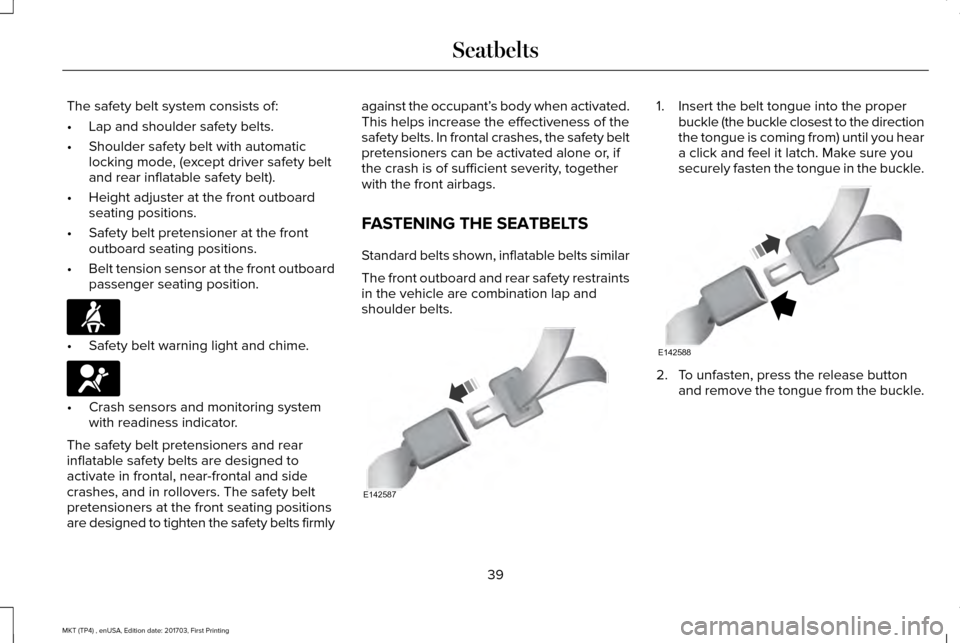
The safety belt system consists of:
•
Lap and shoulder safety belts.
• Shoulder safety belt with automatic
locking mode, (except driver safety belt
and rear inflatable safety belt).
• Height adjuster at the front outboard
seating positions.
• Safety belt pretensioner at the front
outboard seating positions.
• Belt tension sensor at the front outboard
passenger seating position. •
Safety belt warning light and chime. •
Crash sensors and monitoring system
with readiness indicator.
The safety belt pretensioners and rear
inflatable safety belts are designed to
activate in frontal, near-frontal and side
crashes, and in rollovers. The safety belt
pretensioners at the front seating positions
are designed to tighten the safety belts firmly against the occupant’
s body when activated.
This helps increase the effectiveness of the
safety belts. In frontal crashes, the safety belt
pretensioners can be activated alone or, if
the crash is of sufficient severity, together
with the front airbags.
FASTENING THE SEATBELTS
Standard belts shown, inflatable belts similar
The front outboard and rear safety restraints
in the vehicle are combination lap and
shoulder belts. 1. Insert the belt tongue into the proper
buckle (the buckle closest to the direction
the tongue is coming from) until you hear
a click and feel it latch. Make sure you
securely fasten the tongue in the buckle. 2. To unfasten, press the release button
and remove the tongue from the buckle.
39
MKT (TP4) , enUSA, Edition date: 201703, First Printing SeatbeltsE71880 E67017 E142587 E142588
Page 48 of 564
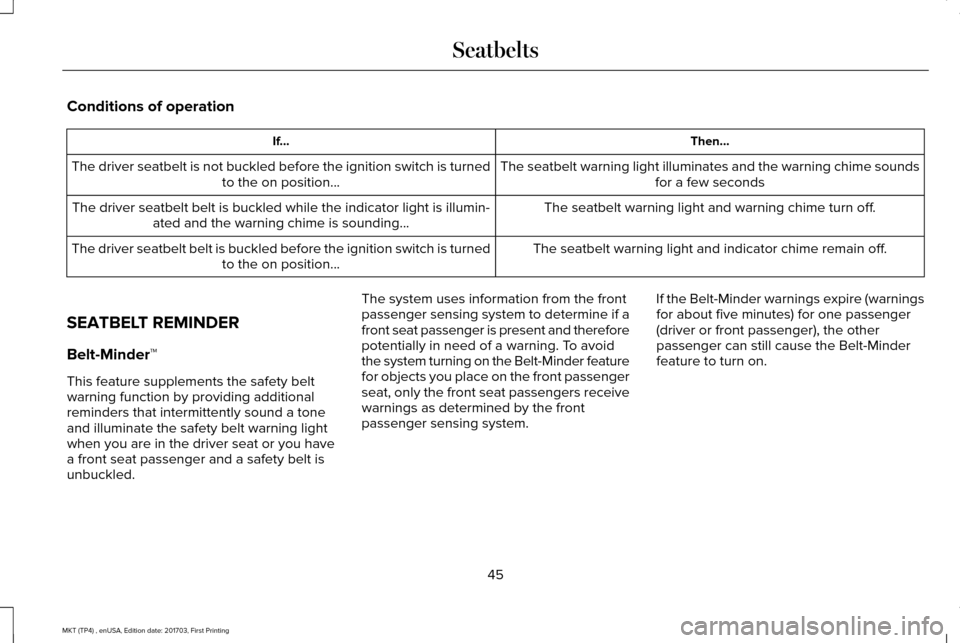
Conditions of operation
Then...
If...
The seatbelt warning light illuminates and the warning chime soundsfor a few seconds
The driver seatbelt is not buckled before the ignition switch is turned
to the on position...
The seatbelt warning light and warning chime turn off.
The driver seatbelt belt is buckled while the indicator light is illumin\
-
ated and the warning chime is sounding...
The seatbelt warning light and indicator chime remain off.
The driver seatbelt belt is buckled before the ignition switch is turned\
to the on position...
SEATBELT REMINDER
Belt-Minder™
This feature supplements the safety belt
warning function by providing additional
reminders that intermittently sound a tone
and illuminate the safety belt warning light
when you are in the driver seat or you have
a front seat passenger and a safety belt is
unbuckled. The system uses information from the front
passenger sensing system to determine if a
front seat passenger is present and therefore
potentially in need of a warning. To avoid
the system turning on the Belt-Minder feature
for objects you place on the front passenger
seat, only the front seat passengers receive
warnings as determined by the front
passenger sensing system.
If the Belt-Minder warnings expire (warnings
for about five minutes) for one passenger
(driver or front passenger), the other
passenger can still cause the Belt-Minder
feature to turn on.
45
MKT (TP4) , enUSA, Edition date: 201703, First Printing Seatbelts
Page 49 of 564
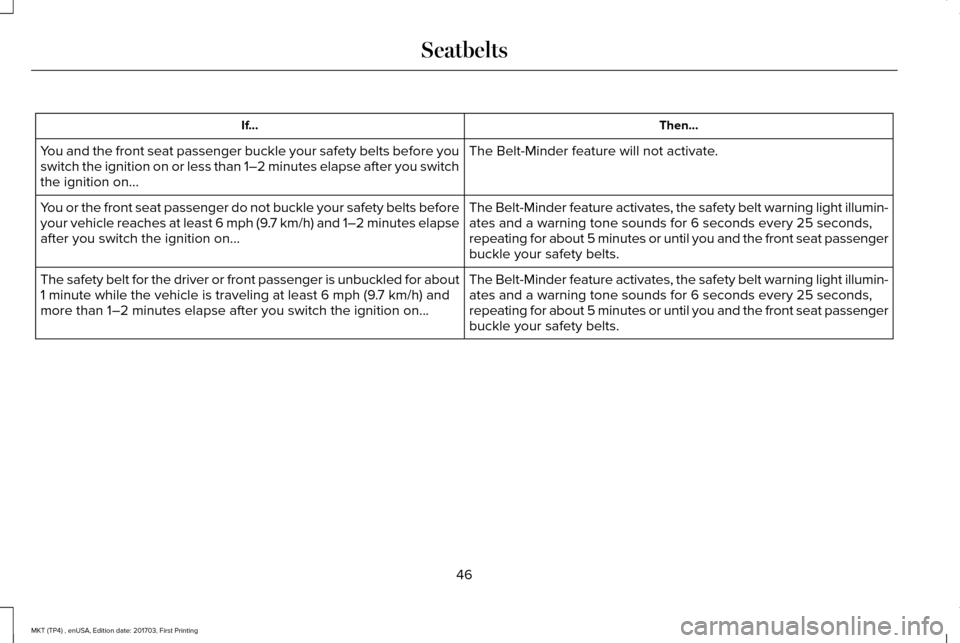
Then...
If...
The Belt-Minder feature will not activate.
You and the front seat passenger buckle your safety belts before you
switch the ignition on or less than 1–2 minutes elapse after you switch
the ignition on...
The Belt-Minder feature activates, the safety belt warning light illumin\
-
ates and a warning tone sounds for 6 seconds every 25 seconds,
repeating for about 5 minutes or until you and the front seat passenger
buckle your safety belts.
You or the front seat passenger do not buckle your safety belts before
your vehicle reaches at least 6 mph (9.7 km/h) and 1–2 minutes elapse
after you switch the ignition on...
The Belt-Minder feature activates, the safety belt warning light illumin\
-
ates and a warning tone sounds for 6 seconds every 25 seconds,
repeating for about 5 minutes or until you and the front seat passenger
buckle your safety belts.
The safety belt for the driver or front passenger is unbuckled for about\
1 minute while the vehicle is traveling at least 6 mph (9.7 km/h) and
more than 1–2 minutes elapse after you switch the ignition on...
46
MKT (TP4) , enUSA, Edition date: 201703, First Printing Seatbelts
Page 50 of 564
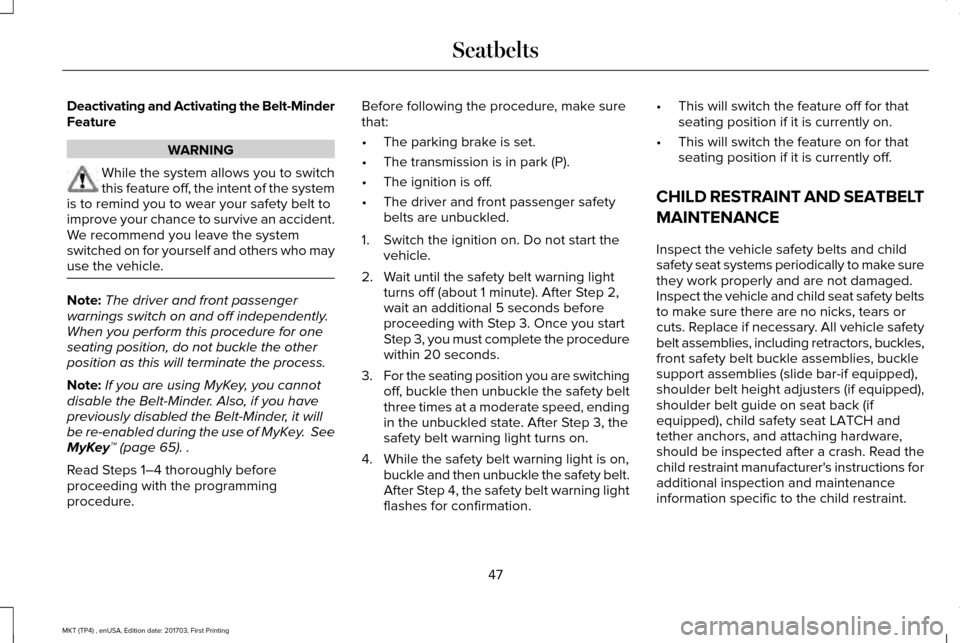
Deactivating and Activating the Belt-Minder
Feature
WARNING
While the system allows you to switch
this feature off, the intent of the system
is to remind you to wear your safety belt to
improve your chance to survive an accident.
We recommend you leave the system
switched on for yourself and others who may
use the vehicle. Note:
The driver and front passenger
warnings switch on and off independently.
When you perform this procedure for one
seating position, do not buckle the other
position as this will terminate the process.
Note: If you are using MyKey, you cannot
disable the Belt-Minder. Also, if you have
previously disabled the Belt-Minder, it will
be re-enabled during the use of MyKey. See
MyKey™ (page 65). .
Read Steps 1–4 thoroughly before
proceeding with the programming
procedure. Before following the procedure, make sure
that:
•
The parking brake is set.
• The transmission is in park (P).
• The ignition is off.
• The driver and front passenger safety
belts are unbuckled.
1. Switch the ignition on. Do not start the vehicle.
2. Wait until the safety belt warning light turns off (about 1 minute). After Step 2,
wait an additional 5 seconds before
proceeding with Step 3. Once you start
Step 3, you must complete the procedure
within 20 seconds.
3. For the seating position you are switching
off, buckle then unbuckle the safety belt
three times at a moderate speed, ending
in the unbuckled state. After Step 3, the
safety belt warning light turns on.
4. While the safety belt warning light is on, buckle and then unbuckle the safety belt.
After Step 4, the safety belt warning light
flashes for confirmation. •
This will switch the feature off for that
seating position if it is currently on.
• This will switch the feature on for that
seating position if it is currently off.
CHILD RESTRAINT AND SEATBELT
MAINTENANCE
Inspect the vehicle safety belts and child
safety seat systems periodically to make sure
they work properly and are not damaged.
Inspect the vehicle and child seat safety belts
to make sure there are no nicks, tears or
cuts. Replace if necessary. All vehicle safety
belt assemblies, including retractors, buckles,
front safety belt buckle assemblies, buckle
support assemblies (slide bar-if equipped),
shoulder belt height adjusters (if equipped),
shoulder belt guide on seat back (if
equipped), child safety seat LATCH and
tether anchors, and attaching hardware,
should be inspected after a crash. Read the
child restraint manufacturer's instructions for
additional inspection and maintenance
information specific to the child restraint.
47
MKT (TP4) , enUSA, Edition date: 201703, First Printing Seatbelts
Page 52 of 564
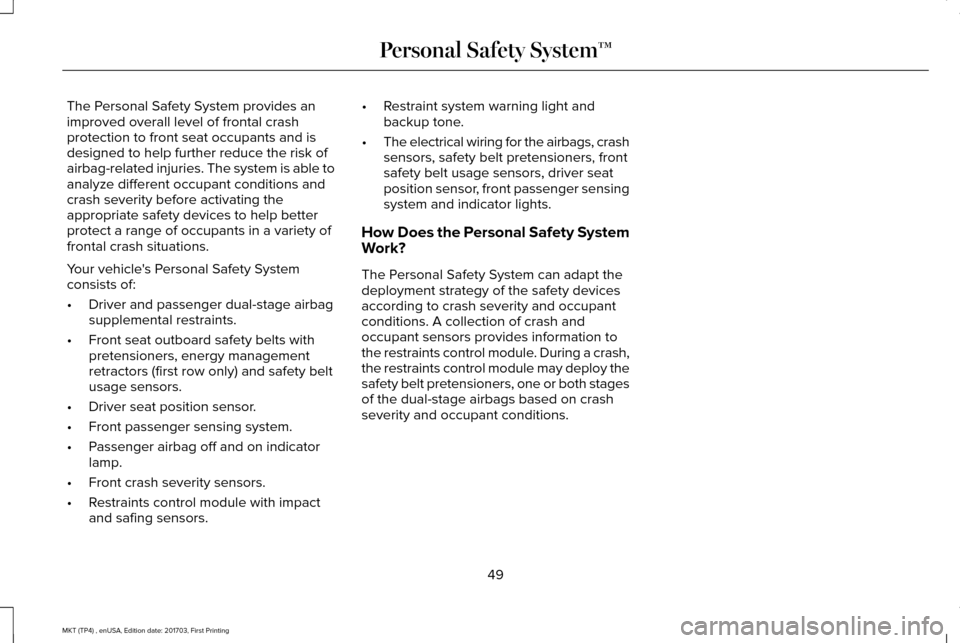
The Personal Safety System provides an
improved overall level of frontal crash
protection to front seat occupants and is
designed to help further reduce the risk of
airbag-related injuries. The system is able to
analyze different occupant conditions and
crash severity before activating the
appropriate safety devices to help better
protect a range of occupants in a variety of
frontal crash situations.
Your vehicle's Personal Safety System
consists of:
•
Driver and passenger dual-stage airbag
supplemental restraints.
• Front seat outboard safety belts with
pretensioners, energy management
retractors (first row only) and safety belt
usage sensors.
• Driver seat position sensor.
• Front passenger sensing system.
• Passenger airbag off and on indicator
lamp.
• Front crash severity sensors.
• Restraints control module with impact
and safing sensors. •
Restraint system warning light and
backup tone.
• The electrical wiring for the airbags, crash
sensors, safety belt pretensioners, front
safety belt usage sensors, driver seat
position sensor, front passenger sensing
system and indicator lights.
How Does the Personal Safety System
Work?
The Personal Safety System can adapt the
deployment strategy of the safety devices
according to crash severity and occupant
conditions. A collection of crash and
occupant sensors provides information to
the restraints control module. During a crash,
the restraints control module may deploy the
safety belt pretensioners, one or both stages
of the dual-stage airbags based on crash
severity and occupant conditions.
49
MKT (TP4) , enUSA, Edition date: 201703, First Printing Personal Safety System
™
Page 55 of 564
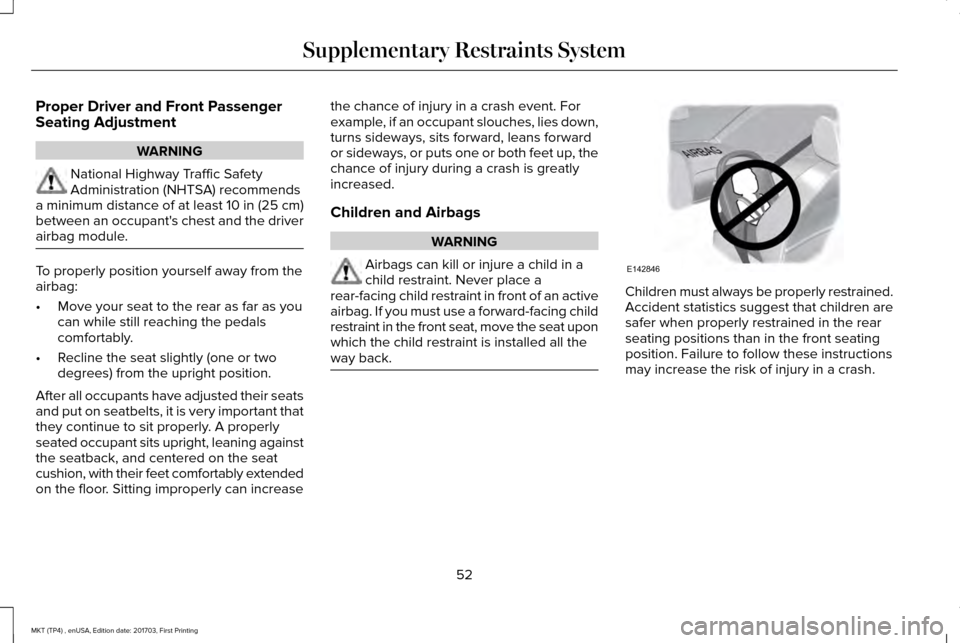
Proper Driver and Front Passenger
Seating Adjustment
WARNING
National Highway Traffic Safety
Administration (NHTSA) recommends
a minimum distance of at least 10 in (25 cm)
between an occupant's chest and the driver
airbag module. To properly position yourself away from the
airbag:
•
Move your seat to the rear as far as you
can while still reaching the pedals
comfortably.
• Recline the seat slightly (one or two
degrees) from the upright position.
After all occupants have adjusted their seats
and put on seatbelts, it is very important that
they continue to sit properly. A properly
seated occupant sits upright, leaning against
the seatback, and centered on the seat
cushion, with their feet comfortably extended
on the floor. Sitting improperly can increase the chance of injury in a crash event. For
example, if an occupant slouches, lies down,
turns sideways, sits forward, leans forward
or sideways, or puts one or both feet up, the
chance of injury during a crash is greatly
increased.
Children and Airbags
WARNING
Airbags can kill or injure a child in a
child restraint. Never place a
rear-facing child restraint in front of an active
airbag. If you must use a forward-facing child
restraint in the front seat, move the seat upon
which the child restraint is installed all the
way back. Children must always be properly restrained.
Accident statistics suggest that children are
safer when properly restrained in the rear
seating positions than in the front seating
position. Failure to follow these instructions
may increase the risk of injury in a crash.
52
MKT (TP4) , enUSA, Edition date: 201703, First Printing Supplementary Restraints SystemE142846